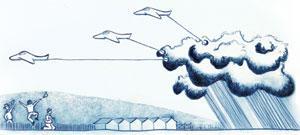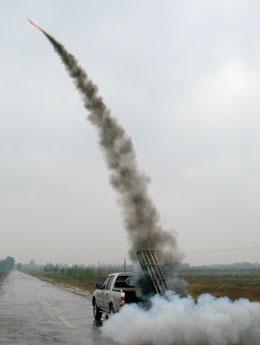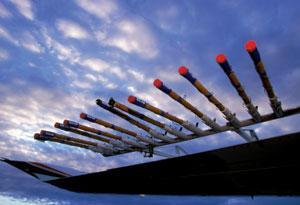
|
| ©N.H.Guan / Associated Press |
| China operates 5,000 rocket launchers as part of its enormous effort to encourage rainfall. |
China wants everything to be under control at the opening of the Beijing Olympic Games on 8 August - even the weather. The chance of rain that day is 47%, according to the Beijing Meteorological Bureau. The iconic 91,000-seat main stadium, nicknamed the 'bird's nest' because of its interlacing steel beams, has no roof. So Chinese meteorologists will use weather-modification technologies to try to stop rain from spoiling the party.
Beijing's plan for the games is the most conspicuous example of the country's massive weather-modification efforts. Most of the time, the focus is not on keeping things dry, but on making it rain in places that desperately need the water. In ancient times, the Chinese believed that dragons controlled the weather, and elaborate rituals were performed to bring about sufficient rainfall and good harvests. Today, they are turning to technology to change the moods of the sky, part of a national obsession to 'tame nature', as championed by Mao Zedong.
China has one of the largest programmes for weather modification in the world. It spends between 400 million yuan (US$60 million) and 700 million yuan a year on it, and employs 32,000 people to operate 35 specially equipped planes, 7,000 anti-aircraft cannons and 5,000 rocket launchers. Official figures from the China Meteorological Administration say that the country created 250 billion tonnes of rain between 1999 and 2006, an annual production of more than 30 billion tonnes. This is enough to meet the needs of more than 500 million of its 1.3 billion people, but the country aims to generate 50 billion tonnes a year by 2010.
Many researchers, both in and outside China, doubt that sufficient evidence has been accumulated to support this claimed success. "In fact, China is very much behind in this area," says Zhang Hong-fa, an atmospheric scientist at the Cold and Arid Regions Environmental and Engineering Research Institute in Lanzhou. "A false sense of achievement would impede genuine progress."
China also faces long-standing scepticism about weather modification in general. Proponents argue that it's possible not only to produce more rain, but also to get rid of fog, prevent hail and even divert hurricanes from making landfall. Critics say that many of these claims are laughable, and that most of the projects under way are based on little more than faith.
Even supporters are dubious about what China may be able to pull off. "The concern for me is that the Chinese are promising they're going to do something that they really don't have optimum assurances they can deliver," says Bruce Boe, director of meteorology at Weather Modification in Fargo, North Dakota, one of the world's largest weather-modification companies. "This has been something that has plagued cloud-seeding since its infancy."
Although people have been trying to influence the weather since early tribes danced at harvest time, scientific weather modification began after work done in 1946, at the General Electric Research Laboratory in upstate New York. There, Vincent Schaefer and Irving Langmuir discovered that seeding clouds with carbon dioxide created nuclei around which water could freeze. Bernard Vonnegut (brother of the novelist Kurt) discovered that silver iodide could also be used, a method that has now been adopted across the globe.
Splashing out
Today, countries from Australia to Iran practise some form of cloud-seeding - as do nearly a dozen US states, mainly in the drought-prone western parts of the country. Estimates vary as to how effective the practice is, although it is generally accepted that increases in rainfall of up to 10% can be accomplished in certain types of clouds. California, for instance, claims that its annual spend of around $3 million has generated an additional 370 million to 490 million cubic metres of water a year - a 4% increase over what would happen without cloud-seeding.
Seeding is generally done in one of two ways, depending on the cloud type. In supercooled clouds, which usually reside at high altitudes, water freezes around particles that serve as nuclei. When the ice crystals get too heavy, they fall from the sky and melt as they go, turning into rain or snow. There can be few particles at high altitudes to serve as nuclei, so seeding supercooled clouds - a process called glaciogenic seeding - aims to add more nuclei. Silver iodide is the most widely used glaciogenic chemical, although other materials, such as solid carbon dioxide, can also be used.
Warmer clouds, which are usually at lower altitude, are targeted through hygroscopic seeding. This approach uses compounds such as sodium, lithium and potassium salts. The idea is to generate larger droplets, either by providing larger nuclei to condense around or encouraging small droplets to come together to form larger drops that can fall. The amount of water vapour and size of the water droplets are crucial for the seeding effects.
Many other factors affect how well cloud-seeding works, such as when and how to apply the chemicals in question. Another factor is which clouds to target: taking into account their temperature, thickness and convective patterns, and the way that the winds flow into and out of them. The criteria, says Boe, are very stringent, and "the majority of clouds fail".
The best clouds to shoot for, many agree, are orographic clouds, which are produced when air is forced upwards over mountain ranges. Such clouds "are short-lived, relatively shallow and contain much water", says Daniel Rosenfeld, an atmospheric scientist at the Hebrew University of Jerusalem. That's why Weather Modification is targeting orographic clouds in Wyoming for one of the largest US seeding projects, the $9-million, five-year Wyoming Weather Modification Pilot Project.
The Wyoming plan calls for one aircraft and remote-controlled units on the ground, which seed clouds in the winter in an effort to create more snow and build up the snowpack for use in the summer when it melts. The first, ground-based-only seeding took place in the winter of 2006 - 07; last year, the plane and 25 ground stations were involved. Daniel Breed, a meteorologist at the US National Center for Atmospheric Research in Boulder, Colorado, who is helping evaluate the programme, says "promising results" suggest that seeding materials are getting into the right clouds and showing up as greater numbers of ice nuclei there.

|
| ©K. Siveyer |
Such work can only help the reputation of weather modification, he says. "There have been a lot of extravagant claims, and it has been a real disservice to science in general, let alone atmospheric science and weather modification."
Each to their own
Most of the work in China focuses on promoting rain and deterring hail, in an effort to reduce damage to agricultural crops, but some of it deals with breaking up fog or diverting lightning[1]. Most of China's 34 districts have their own weather-modification office, and close to two-thirds of its 2,900 counties have their own cloud-seeding stations.
Some Chinese rain-makers have tried to conduct controlled seeding experiments to evaluate how effective the technique is. For example, Shi Li-xin, deputy director of the weather-modification office at the Hebei Meteorological Bureau, and his colleagues have been trying to identify suitable seeding conditions by studying the properties of clouds using a combination of ground and satellite technologies, as well as in situ measurements by planes. After assessing factors such as cloud thickness, the content of supercooled water and the suitable seeding layer of the cloud, the team selected three regions - one operational region of 36,500 square kilometres, and two controls that cover 19,800 and 20,000 square kilometres each. In the early 1990s, the researchers found that rainfall rose by 18% as a result of 21 seeding operations - but the sample was too small for the results to be statistically significant.
In an earlier study, conducted between 1975 and 1986, meteorologists in Fujian province, in southeast China, conducted a randomized seeding experiment with two 14,000-square-kilometre regions. Over the course of 244 experimental days, they found that areas that had been seeded had 20% more rainfall than did those that had been left to their own devices.

|
| ©Weather Modification Centre, China Meteorological Administration |
| Choosing which cloud to seed, and which approach to use, can greatly affect the outcome. |
Still, the results of these cloud-seeding experiments have not been published in peer-reviewed journals, and much scepticism lingers. According to Shi, the national statistics on rain creation come from weather-modification offices at all levels, from federal down to provincial and village offices. And as they are tied to performance appraisals and funding for the offices, there is plenty of incentive to exaggerate.
A source close to the China Meteorological Administration, who asked not to be named for fear of political repercussion, says that such scepticism is secretly shared by many Chinese atmospheric scientists and meteorological officials. "You may think that the solution is straightforward: stop applying cloud-seeding technologies until their effectiveness is proved," he says. "But it's not so simple."
"There is a huge demand from the farmers for those technologies," says Lu Da-ren, a researcher at the Beijing-based Institute of Atmospheric Physics, part of the Chinese Academy of Sciences. "So it's not just a scientific issue." Lu admits that the effectiveness of weather modification needs to be better validated, but maintains that this should not exclude a trial-and-error approach at the same time. "Maybe it's not as effective as one thinks," he says. But "from the farmers' point of view, it's better than nothing".
For the Olympics, the Beijing Meteorological Bureau aims to change how and when the rain falls. Starting in 2002, the year after Beijing was chosen to host the games, the bureau has used radar, satellites and weather balloons to scrutinize properties such as structure, temperature and size of droplets of clouds passing over Beijing, as well as over the adjacent Tianjin municipality and Hebei province.
Chinese rain-makers plan to get the clouds to rain out before reaching Beijing, or to prevent small clouds from getting bigger by dissipating them with salt. Failing that, they will over-seed the clouds hoping to reduce the size of each water droplet or ice crystal, which is then more likely to be dissipated before reaching the ground. The meteorological bureaus have amassed cannons, rocket launchers and planes in more than 100 locations in Beijing, Tianjin and Hebei.
In recent months, the bureaus have intensified their field testing. The Beijing Meteorological Bureau declined to provide details of the results, but maintains that keeping the opening ceremonies dry will depend largely on the cloud properties and the accuracy of the weather forecast. "We can achieve reasonably good results with local, weak weather patterns, but are unable to bring about complete elimination of rain in face of large, thick clouds covering a large region," the bureau said in a statement.
Sketchy evidence
Part of the problem is that so little is known about the mechanisms through which cloud-seeding might work. An influential 2003 report2 from the US National Research Council (NRC) declared that "there still is no convincing scientific proof of the efficacy of intentional weather-modification efforts". A riposte from the Weather Modification Association accused the members of the panel of lacking experience or knowledge of weather modification - and said they had held cloud seeding to a standard of scientific proof "that few atmospheric problems could satisfy".
For one thing, clouds can be very different at distinct locations; they also vary over time at a particular place. And lack of funding in some countries hasn't helped; in the United States, for example, federal funding for weather modification peaked at around $20 million a year in the late 1970s, but is now negligible. States have been left on their own to fund individual projects. "We have been in the dark ages in terms of scientific research in weather modification for going on 25 years," says William Cotton, an atmospheric physicist at Colorado State University in Fort Collins. "And so when somebody wants to have something really quantitative, we can't deliver."
"It is the same problem as weather forecasting," adds Deon Terblanche, divisional manager of research for the South African Weather Service in Pretoria and chairman of the World Meteorological Organization's Expert Team on Weather Modification. "It's very difficult to forecast even 30 minutes ahead what a specific cloud will do. If you do something to that cloud and you can't even forecast what it will do exactly in nature, it becomes difficult to prove what your effect was." He does, however, think that some of the weather-modification technologies currently in use show a big enough effect to be statistically significant.
Michael Manton, of Monash University in Victoria, Australia, cites three reasons for the difficulties in proving the impact of cloud seeding: a mismatch between the scale of the impact and the scale at which seeding acts; the natural variability of rainfall versus the incremental impact of seeding; and the expense of evaluation. "I believe we have not moved significantly forward since [the NRC report in] 2003," he says. "In many parts of the world there has been an implicit or explicit faith in cloud seeding, so seeding has not been carried out under carefully controlled conditions."

|
| ©P. McBride/Aurora/Getty Images |
| Light aircraft are used to seed clouds with compounds such as silver iodide. |
Moreover, there is growing realization of the importance of air-pollution aerosols on cloud formation and precipitation. Some researchers think that aerosols can reduce rainfall by decreasing the size of water droplets in warm clouds; there are also indications that aerosols could affect precipitation in cold clouds and the dynamics between the two cloud systems, says Zhanqing Li, of the University of Maryland in College Park. "This may be a missing piece of the jigsaw in the puzzle of cloud-seeding research. Under inappropriate seeding conditions, we may get the opposite effect to what is intended."
The problem with aerosols underlies a new debate on whether Israel's randomized seeding experiments - once seen as some of the most convincing evidence for the effects of cloud-seeding - were as effective as once thought. Two long-running experiments, each of which was carried out over 6 years in the 1960s and 1970s, suggested that seeding increased rainfall by 12 - 15%. But some have questioned those conclusions. Most recently, an ongoing study led by Zev Levin of Tel Aviv University took aerosols into consideration and showed that seeding might have zero or even negative effects in regions with high levels of pollution. "This is just the beginning of the debate, but strikes a note of caution on large-scale cloud-seeding operations in the presence of heavy pollution," says Li. This is, of course, a particular concern for China, with its heavy aerosol burden.
Israel's water commission has just launched another major cloud-seeding experiment, with a budget of US$1 million a year for several years. Researchers from the Hebrew University of Jerusalem and Tel Aviv University will build on what has been learned from previous experiments and incorporate cutting-edge technologies to measure cloud properties and to trace seeding materials and assess their role in rain formation. The ultimate goal is to see whether technologies can replenish water reserves in Lake Tiberius (also known as the Sea of Galilee) in northern Israel.
A report, commissioned by the World Meteorological Organization and the International Union of Geodesy and Geophysics, calls for a better understanding of the role of aerosols in precipitation and climate systems. "Aerosols are involved in a long chain of reactions and complicated feedback mechanisms leading to precipitation," says Levin, chief editor of the report, which will be released within the next month. "Cloud seeding adds to that complexity we know so little of." In addition, the report stresses the serious limitation of using statistical tools in cloud seeding without a proper understanding of the underlying physical processes.
Rosenfeld maintains that the Chinese will be able to make genuine progress only by combining approaches such as measurements of cloud properties, numerical modelling, as well as randomized and targeted seeding experiments. "Without these cloud-seeding technologies, the Chinese are just shooting in the dark," he says.
But long-term, randomized or targeted seeding experiments over a large region would mean forgoing opportunities to seed suitable clouds, and to some Chinese meteorologists, this is unthinkable given the country's water crisis. "If suitable clouds are there, we have to conduct cloud-seeding operations," says Shi. "The farmers would be furious if we didn't." The stakes are so high that in some instances, farmers have accused those in neighbouring villages of "stealing" their rain by seeding passing clouds.
Many researchers are concerned that China's weather-modification scheme has been heavily tilted towards operations, and that researchers and operations managers need to collaborate much more than they have until now. The newly established Centre for Weather Modification at the Chinese Academy of Meteorological Sciences may help start to address some of these issues, says its director, Guo Xueliang. The centre, set up last December, will eventually house some 60 researchers. They will use numerical models, laboratory simulation and field experiments to analyse cloud properties and precipitation principles. "We recognize the importance of basic research in guiding cloud-seeding operations, and will apply scientific rigour in testing their effectiveness in controlled, cross-province field experiments," Guo says.
And China's lavish programme is likely to receive even more money; the country has listed weather modification as one of the key projects in its eleventh five-year plan, and says it will introduce the latest equipment for both research and operations. Several large-scale national projects are also in place to aid collaboration between academic institutes and meteorological offices, such as a five-year project funded by the science ministry.
China has found plenty of reasons to move forwards with its work. As the momentum of the Olympics gathers pace, the Beijing Meteorological Bureau is under increasing pressure to give its best performance yet. The promised extravaganza of the opening ceremony will not be the only focal point as the opening ceremonies begin; meteorologists around the world are also eager to hear what Beijing will say about its rain-suppression operations - especially if the weather turns out to be dry.
References
1. Guo, X. & Zheng, G. Adv. Atmos. Sci. (in the press).
2. National Research Council. Critical Issues in Weather Modification Research (National Academies, 2003).
3. Yang, J. et al. Atmos. Res. (in the press).
4. Kasparian, J. et al. Opt. Express 16, 5757 - 5763 (2008).
5. Smith, P. L., Johnson, L. R. & Priegnitz, D.L., Boe, B. L. & Mielke, P. W. J. Appl. Meteorol. 36, 463 - 473 (1997).
6. Rosenfeld, D. et al. Atmos. Chem. Phys. Discuss. 7, 5647 - 5674 (2007).
7. Cotton, W. R., Zhang, H., McFarquhar, G. M. & Saleeby, S. M. J. Weather Modification 39, 70 - 73 (2007).



Makes me wonder if this could be used to flood grain and corn producing states to increase food shortages and famine.....say in Iowa and surrounding states?
Not that this is what happened. Of course, not.